Презентация Ways of Word-Building
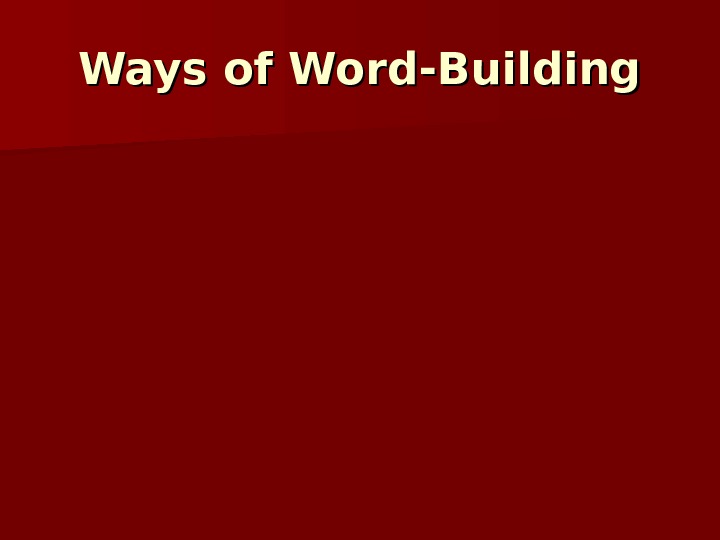

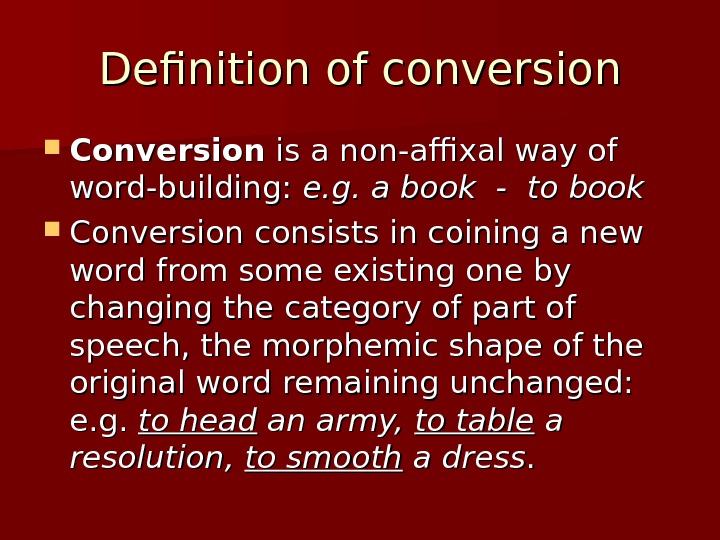
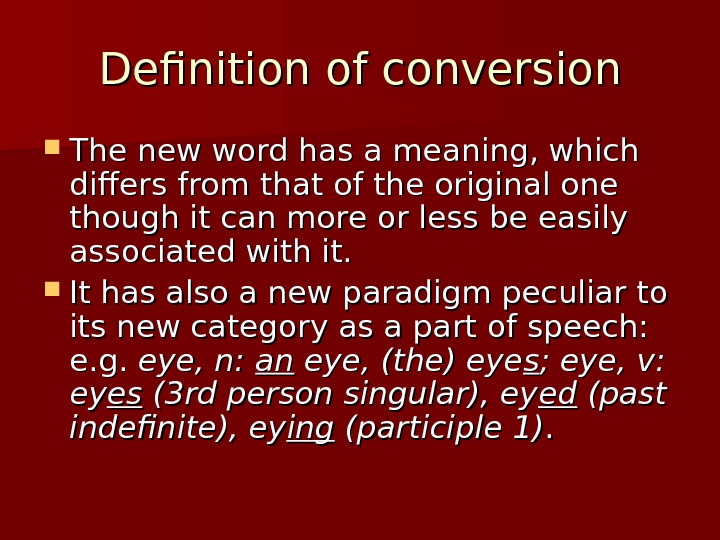

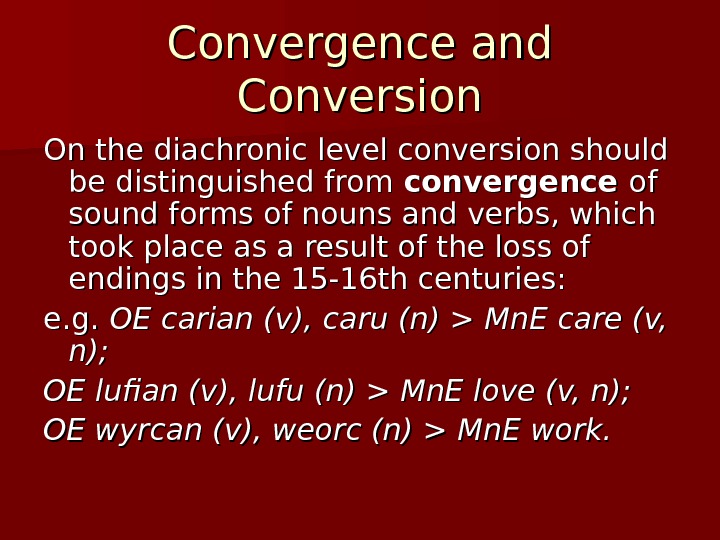
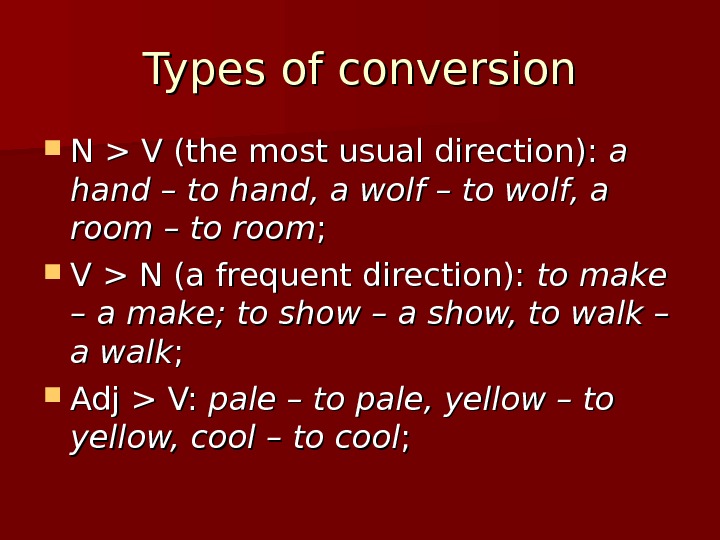





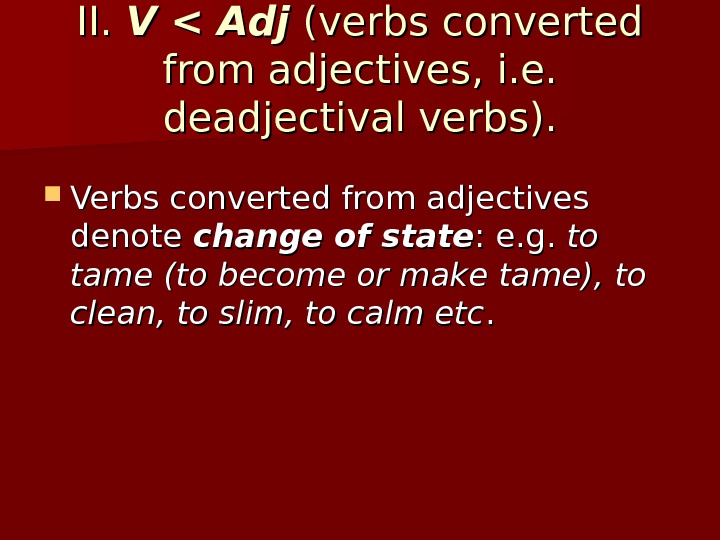
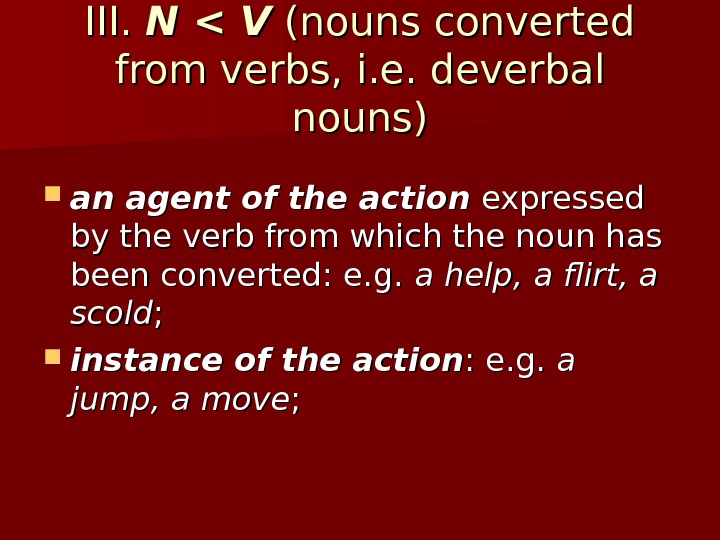


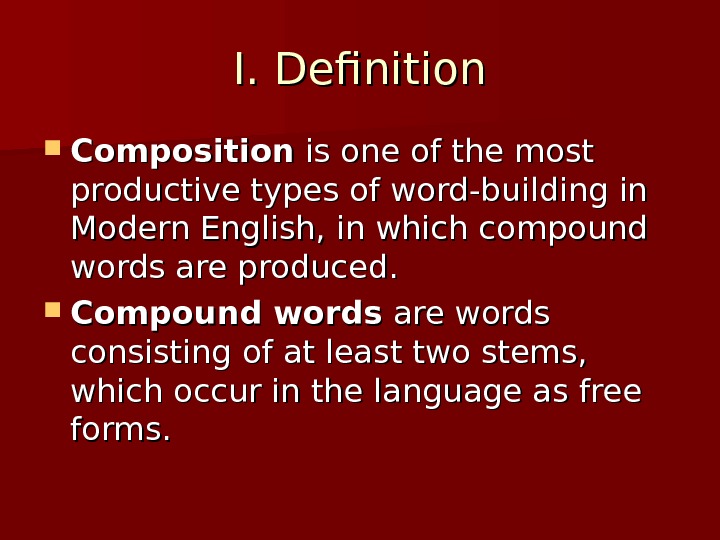

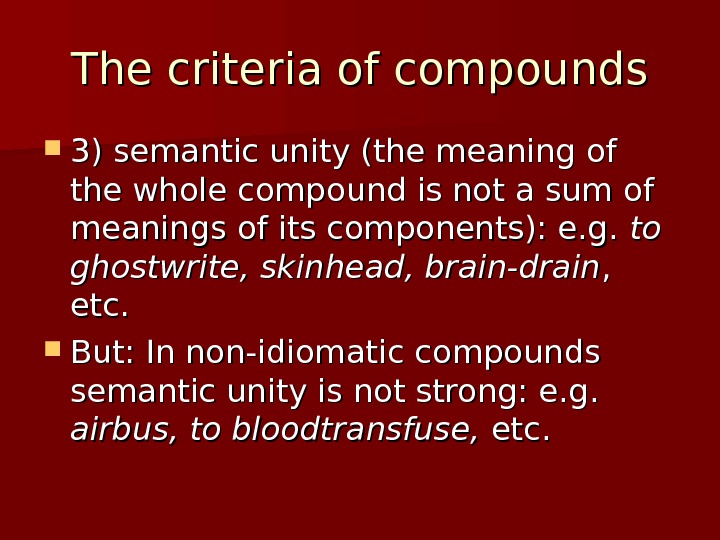


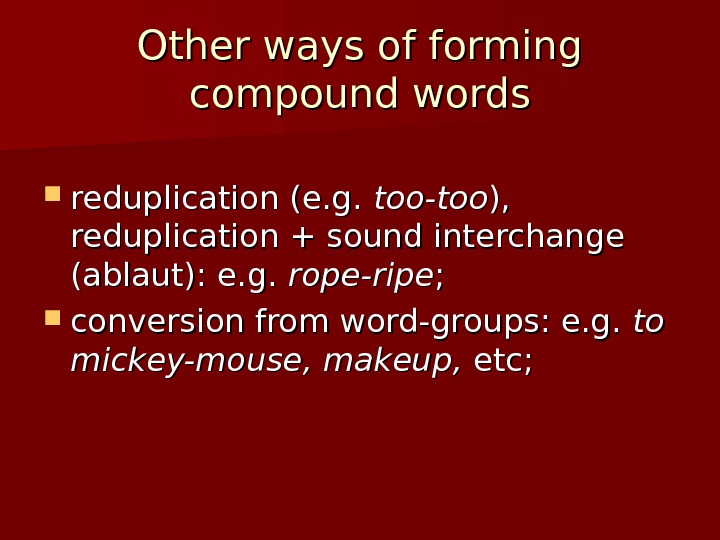


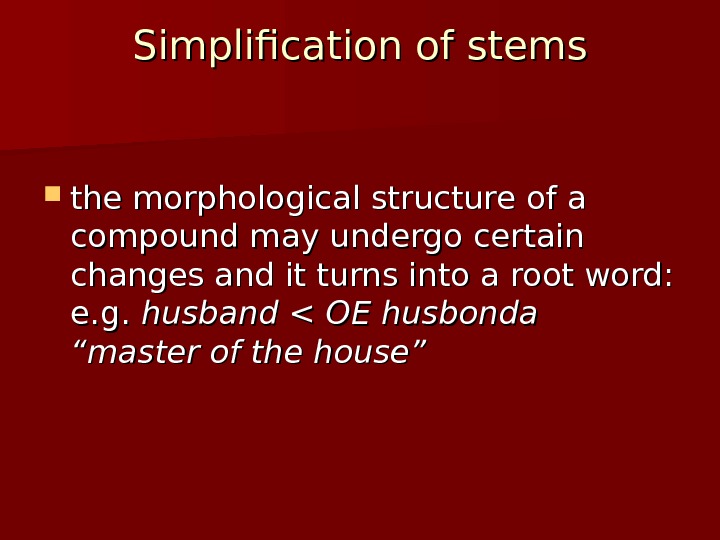

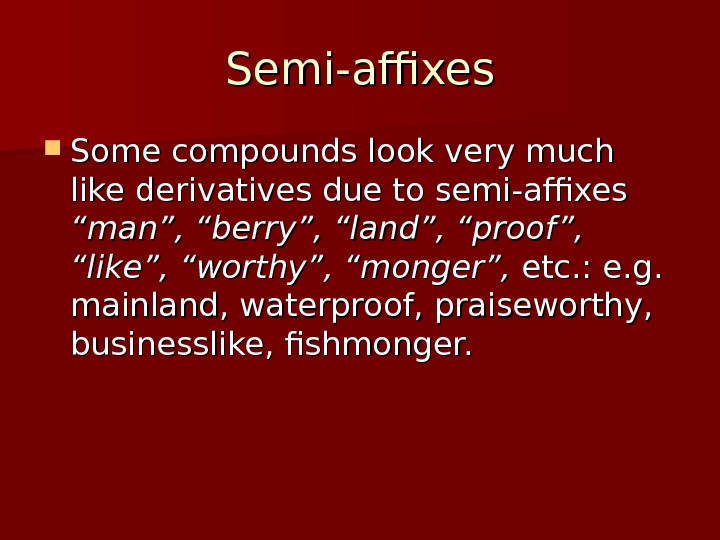



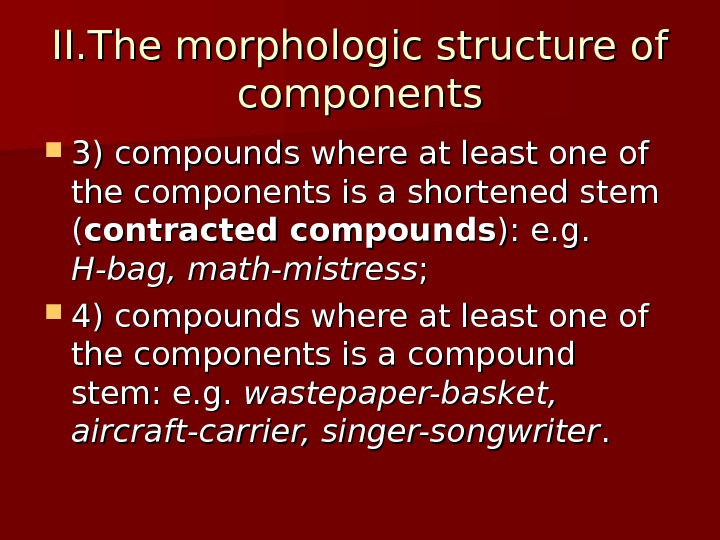
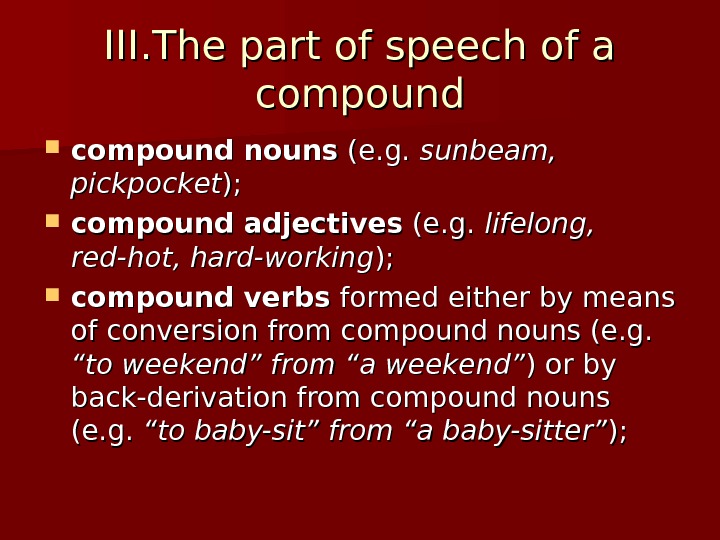
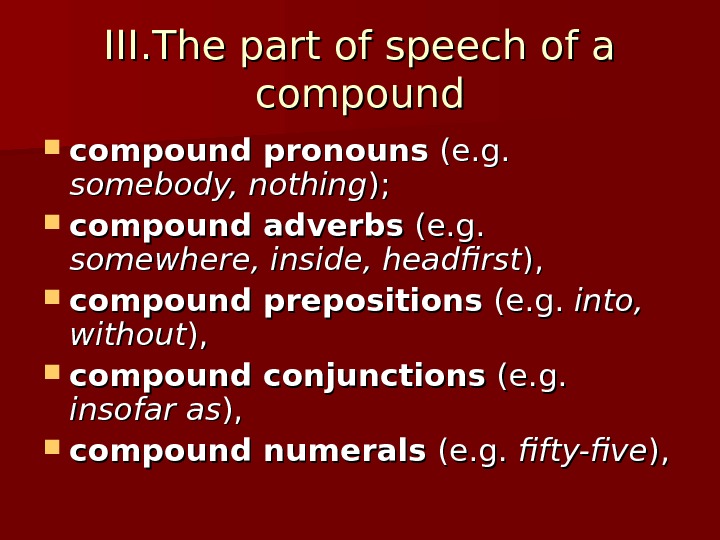
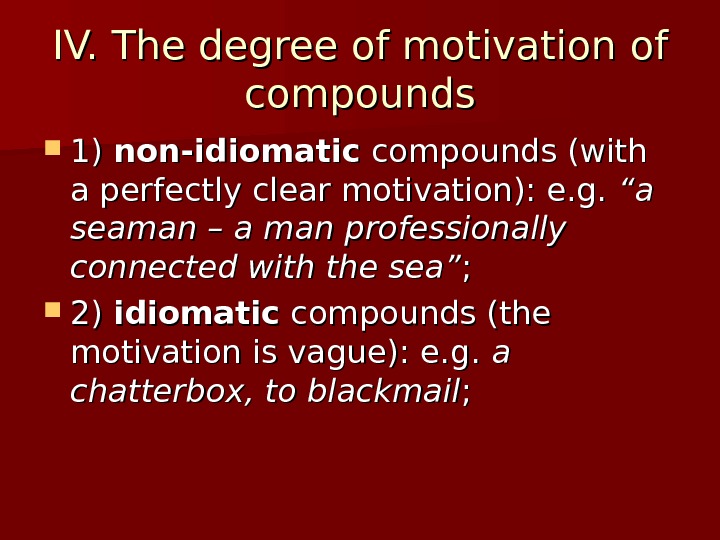



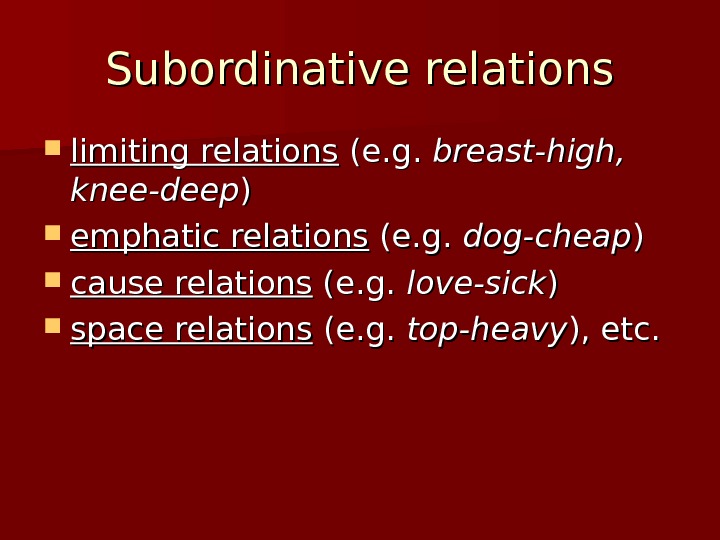

- Размер: 72 Кб
- Количество слайдов: 39
Описание презентации Презентация Ways of Word-Building по слайдам
 Ways of Word-Building
Ways of Word-Building
 Conversion I. Definition of conversion: a) different approaches to the phenomenon of conversion; b) conversion and convergence; c) semantic development of the resultant word. II. Types of conversion. Adjectivization and substantivation. III. Semantic relations in converted words.
Conversion I. Definition of conversion: a) different approaches to the phenomenon of conversion; b) conversion and convergence; c) semantic development of the resultant word. II. Types of conversion. Adjectivization and substantivation. III. Semantic relations in converted words.
 Definition of conversion Conversion is a non-affixal way of word-building: e. g. a book — to book Conversion consists in coining a new word from some existing one by changing the category of part of speech, the morphemic shape of the original word remaining unchanged: e. g. to head an army, to table a a resolution, to smooth a dress. .
Definition of conversion Conversion is a non-affixal way of word-building: e. g. a book — to book Conversion consists in coining a new word from some existing one by changing the category of part of speech, the morphemic shape of the original word remaining unchanged: e. g. to head an army, to table a a resolution, to smooth a dress. .
 Definition of conversion The new word has a meaning, which differs from that of the original one though it can more or less be easily associated with it. It has also a new paradigm peculiar to its new category as a part of speech: e. g. eye, n: anan eye, (the) eye ss ; eye, v: eyey eses (3 rd person singular), ey eded (past indefinite), ey inging (participle 1). .
Definition of conversion The new word has a meaning, which differs from that of the original one though it can more or less be easily associated with it. It has also a new paradigm peculiar to its new category as a part of speech: e. g. eye, n: anan eye, (the) eye ss ; eye, v: eyey eses (3 rd person singular), ey eded (past indefinite), ey inging (participle 1). .
 Productivity of conversion The productivity of conversion in the English language is encouraged by the analytical structure of this language, the simplicity of paradigms of English parts of speech, a great number of one-syllable words.
Productivity of conversion The productivity of conversion in the English language is encouraged by the analytical structure of this language, the simplicity of paradigms of English parts of speech, a great number of one-syllable words.
 Convergence and Conversion On the diachronic level conversion should be distinguished from convergence of of sound forms of nouns and verbs, which took place as a result of the loss of endings in the 15 -16 th centuries: e. g. OE carian (v), caru (n) > Mn. E care (v, n); OE lufian (v), lufu (n) > Mn. E love (v, n); OE wyrcan (v), weorc (n) > Mn. E work.
Convergence and Conversion On the diachronic level conversion should be distinguished from convergence of of sound forms of nouns and verbs, which took place as a result of the loss of endings in the 15 -16 th centuries: e. g. OE carian (v), caru (n) > Mn. E care (v, n); OE lufian (v), lufu (n) > Mn. E love (v, n); OE wyrcan (v), weorc (n) > Mn. E work.
 Types of conversion N > V (the most usual direction): a a hand – to hand, a wolf – to wolf, a room – to room ; ; V > N (a frequent direction): to make – a make; to show – a show, to walk – a walk ; ; Adj > V: pale – to pale, yellow – to yellow, cool – to cool ; ;
Types of conversion N > V (the most usual direction): a a hand – to hand, a wolf – to wolf, a room – to room ; ; V > N (a frequent direction): to make – a make; to show – a show, to walk – a walk ; ; Adj > V: pale – to pale, yellow – to yellow, cool – to cool ; ;
 Types of conversion N > Adj ( adjectivization of nouns ): ): “a “a stone wall”, “a village school” ; ; Adj > N ( substantivation of adjectives ): partial (e. g. the blind, the unemployed, the wounded ) or complete (e. g. a private, the private(s), the private’s ); ); Prep / Conj > N: “ins”, “buts”, “ifs”. .
Types of conversion N > Adj ( adjectivization of nouns ): ): “a “a stone wall”, “a village school” ; ; Adj > N ( substantivation of adjectives ): partial (e. g. the blind, the unemployed, the wounded ) or complete (e. g. a private, the private(s), the private’s ); ); Prep / Conj > N: “ins”, “buts”, “ifs”. .
 Semantic relations in converted words
Semantic relations in converted words
 I. I. V < N (verbs converted from nouns, i. e. denominal verbs) verbs have instrumental meaning if they are formed from nouns denoting parts of the human body or from nouns denoting tools, machines, instruments, weapons: e. g. to to eye, to finger, to elbow, to shoulder; to hammer, to machine-gun, to rifle, to nail ; ; verbs can denote an action characteristic of the living being denoted by the noun from which they have been converted: e. g. to crowd, to nurse, to wolf, to ape ; ;
I. I. V < N (verbs converted from nouns, i. e. denominal verbs) verbs have instrumental meaning if they are formed from nouns denoting parts of the human body or from nouns denoting tools, machines, instruments, weapons: e. g. to to eye, to finger, to elbow, to shoulder; to hammer, to machine-gun, to rifle, to nail ; ; verbs can denote an action characteristic of the living being denoted by the noun from which they have been converted: e. g. to crowd, to nurse, to wolf, to ape ; ;
 V < N verbs can denote acquisition or addition of an object denoted by the noun from which they have been converted: e. g. to fish, to paper ; ; verbs can denote deprivation or removal of an object denoted by the noun from which they have been converted: e. g. to dust, to peel ; ;
V < N verbs can denote acquisition or addition of an object denoted by the noun from which they have been converted: e. g. to fish, to paper ; ; verbs can denote deprivation or removal of an object denoted by the noun from which they have been converted: e. g. to dust, to peel ; ;
 V < N verbs can be locative if they are converted from nouns denoting places, buildings, containers: e. g. to park, to garage, to bottle, to corner, to pocket ; ; verbs can denote an action performed at the time denoted by the noun from which they have been converted: e. g. to winter, to week-end. .
V < N verbs can be locative if they are converted from nouns denoting places, buildings, containers: e. g. to park, to garage, to bottle, to corner, to pocket ; ; verbs can denote an action performed at the time denoted by the noun from which they have been converted: e. g. to winter, to week-end. .
 II. V < Adj (verbs converted from adjectives, i. e. deadjectival verbs). Verbs converted from adjectives denote change of state : e. g. to to tame (to become or make tame), to clean, to slim, to calm etc. .
II. V < Adj (verbs converted from adjectives, i. e. deadjectival verbs). Verbs converted from adjectives denote change of state : e. g. to to tame (to become or make tame), to clean, to slim, to calm etc. .
 III. N < V (nouns converted from verbs, i. e. deverbal nouns) an agent of the action expressed by the verb from which the noun has been converted: e. g. a help, a flirt, a scold ; ; instance of the action : e. g. a a jump, a move ; ;
III. N < V (nouns converted from verbs, i. e. deverbal nouns) an agent of the action expressed by the verb from which the noun has been converted: e. g. a help, a flirt, a scold ; ; instance of the action : e. g. a a jump, a move ; ;
 N < V place of the action : e. g. a drive, a stop, a walk ; ; object or result of the action : e. g. a find, peel. . process or state : e. g. sleep, walk. .
N < V place of the action : e. g. a drive, a stop, a walk ; ; object or result of the action : e. g. a find, peel. . process or state : e. g. sleep, walk. .
 WORD-COMPOSITION I. Definition of compound words. Specific features of English compounds. Composition and other ways of forming compound words. A compound and a phrase: the criteria of compounds. II. Diachronic approach to compounds: simplification, demotivation, semi-affixes. III. Classification of compounds.
WORD-COMPOSITION I. Definition of compound words. Specific features of English compounds. Composition and other ways of forming compound words. A compound and a phrase: the criteria of compounds. II. Diachronic approach to compounds: simplification, demotivation, semi-affixes. III. Classification of compounds.
 I. Definition Composition is one of the most productive types of word-building in Modern English, in which compound words are produced. Compound words are words consisting of at least two stems, which occur in the language as free forms.
I. Definition Composition is one of the most productive types of word-building in Modern English, in which compound words are produced. Compound words are words consisting of at least two stems, which occur in the language as free forms.
 The criteria of compounds Structural cohesion: 1) the unity of stress (e. g. a `blackboard vs a `black `board ), ), But: Double stress: e. g. ‘ snow-’white, ‘sky-’blue 2) solid or hyphenated spelling (e. g. homework, exercise-book ), ), But: Different spelling (e. g. blood-vessel / blood vessel ); ); block compounds (one uniting stress but spelt with a break): e. g. air piracy, cargo module, coin change, etc. .
The criteria of compounds Structural cohesion: 1) the unity of stress (e. g. a `blackboard vs a `black `board ), ), But: Double stress: e. g. ‘ snow-’white, ‘sky-’blue 2) solid or hyphenated spelling (e. g. homework, exercise-book ), ), But: Different spelling (e. g. blood-vessel / blood vessel ); ); block compounds (one uniting stress but spelt with a break): e. g. air piracy, cargo module, coin change, etc. .
 The criteria of compounds 3) semantic unity (the meaning of the whole compound is not a sum of meanings of its components): e. g. to to ghostwrite, skinhead, brain-drain , , etc. But: In non-idiomatic compounds semantic unity is not strong: e. g. airbus, to bloodtransfuse, etc.
The criteria of compounds 3) semantic unity (the meaning of the whole compound is not a sum of meanings of its components): e. g. to to ghostwrite, skinhead, brain-drain , , etc. But: In non-idiomatic compounds semantic unity is not strong: e. g. airbus, to bloodtransfuse, etc.
 The criteria of compounds 4) the unity of morphologic and syntactic functioning, i. e. they are used in a sentence as one part of it and only one component changes grammatically (e. g. These girls are chatter-boxes. ), 5) indivisibility, i. e. the impossibility of inserting another word or word-group between its components.
The criteria of compounds 4) the unity of morphologic and syntactic functioning, i. e. they are used in a sentence as one part of it and only one component changes grammatically (e. g. These girls are chatter-boxes. ), 5) indivisibility, i. e. the impossibility of inserting another word or word-group between its components.
 Specific features of English compounds 1) Both components in an English compound are free stems, i. e. they can be used as words with a distinctive meaning of their own: e. g. «a green-house» and «a green house». 2) English compounds have a two-stem pattern, with the exception of compound words which have form-word stems in their structure: e. g. middle-of-the-road, off-the-record, up-and-coming, etc.
Specific features of English compounds 1) Both components in an English compound are free stems, i. e. they can be used as words with a distinctive meaning of their own: e. g. «a green-house» and «a green house». 2) English compounds have a two-stem pattern, with the exception of compound words which have form-word stems in their structure: e. g. middle-of-the-road, off-the-record, up-and-coming, etc.
 Other ways of forming compound words reduplication (e. g. too-too ), ), reduplication + sound interchange (ablaut): e. g. rope-ripe ; ; conversion from word-groups: e. g. to to mickey-mouse, makeup, etc;
Other ways of forming compound words reduplication (e. g. too-too ), ), reduplication + sound interchange (ablaut): e. g. rope-ripe ; ; conversion from word-groups: e. g. to to mickey-mouse, makeup, etc;
 Other ways of forming compound words back formation from compound nouns or word-groups: e. g. to to bloodtransfuse, to fingerprint, etc. ; analogy: e. g. lie-in, phone-in (on the analogy with “sit-in”), brawn-drain (on the analogy with brain-drain), etc.
Other ways of forming compound words back formation from compound nouns or word-groups: e. g. to to bloodtransfuse, to fingerprint, etc. ; analogy: e. g. lie-in, phone-in (on the analogy with “sit-in”), brawn-drain (on the analogy with brain-drain), etc.
 II. Diachronic approach to compounds
II. Diachronic approach to compounds
 Simplification of stems the morphological structure of a compound may undergo certain changes and it turns into a root word: e. g. husband < OE husbonda “master of the house”
Simplification of stems the morphological structure of a compound may undergo certain changes and it turns into a root word: e. g. husband < OE husbonda “master of the house”
 Demotivation Due to etymological isolation a a compound may lose its ties with formerly correlated words: e. g. breakfast (literally means “to interrupt going without food / прервать пост ”), kidnap (literally means “to seize a young goat”).
Demotivation Due to etymological isolation a a compound may lose its ties with formerly correlated words: e. g. breakfast (literally means “to interrupt going without food / прервать пост ”), kidnap (literally means “to seize a young goat”).
 Semi-affixes Some compounds look very much like derivatives due to semi-affixes “man”, “berry”, “land”, “proof”, “like”, “worthy”, “monger”, etc. : e. g. mainland, waterproof, praiseworthy, businesslike, fishmonger.
Semi-affixes Some compounds look very much like derivatives due to semi-affixes “man”, “berry”, “land”, “proof”, “like”, “worthy”, “monger”, etc. : e. g. mainland, waterproof, praiseworthy, businesslike, fishmonger.
 III. Classification of compounds
III. Classification of compounds
 I. The means of joining the components: 1) 1) neutral , i. e. words with a mere juxtaposition of components without connecting elements: e. g. headache, film-star, blockbuster ; ; 2) 2) morphological , i. e. words whose components are joined together with a vowel or a consonant as a linking element: e. g. speed oo meter, hand ii craft, state ss manman ; ; 3) 3) syntactical , i. e. words with linking elements represented by form-word stems: e. g. down-and-out, sister-in-law. .
I. The means of joining the components: 1) 1) neutral , i. e. words with a mere juxtaposition of components without connecting elements: e. g. headache, film-star, blockbuster ; ; 2) 2) morphological , i. e. words whose components are joined together with a vowel or a consonant as a linking element: e. g. speed oo meter, hand ii craft, state ss manman ; ; 3) 3) syntactical , i. e. words with linking elements represented by form-word stems: e. g. down-and-out, sister-in-law. .
 II. T he morphologic structure of components 1) compounds consisting of simple stems ( compounds proper ): e. g. bookcase, blackbird ; ; 2) compounds where at least one of the components is a derived stem (( derived, or derivational compounds ): e. g. long-legged, chain-smoker ; ;
II. T he morphologic structure of components 1) compounds consisting of simple stems ( compounds proper ): e. g. bookcase, blackbird ; ; 2) compounds where at least one of the components is a derived stem (( derived, or derivational compounds ): e. g. long-legged, chain-smoker ; ;
 II. T he morphologic structure of components 3) compounds where at least one of the components is a shortened stem (( contracted compounds ): e. g. H-bag, math-mistress ; ; 4) compounds where at least one of the components is a compound stem: e. g. wastepaper-basket, aircraft-carrier, singer-songwriter. .
II. T he morphologic structure of components 3) compounds where at least one of the components is a shortened stem (( contracted compounds ): e. g. H-bag, math-mistress ; ; 4) compounds where at least one of the components is a compound stem: e. g. wastepaper-basket, aircraft-carrier, singer-songwriter. .
 III. The part of speech of a compound nouns (e. g. sunbeam, pickpocket ); ); compound adjectives (e. g. lifelong, red-hot, hard-working ); ); compound verbs formed either by means of conversion from compound nouns (e. g. “to weekend” from “a weekend” ) or by back-derivation from compound nouns (e. g. “to baby-sit” from “a baby-sitter” ); );
III. The part of speech of a compound nouns (e. g. sunbeam, pickpocket ); ); compound adjectives (e. g. lifelong, red-hot, hard-working ); ); compound verbs formed either by means of conversion from compound nouns (e. g. “to weekend” from “a weekend” ) or by back-derivation from compound nouns (e. g. “to baby-sit” from “a baby-sitter” ); );
 III. The part of speech of a compound pronouns (e. g. somebody, nothing ); ); compound adverbs (e. g. somewhere, inside, headfirst ), ), compound prepositions (e. g. into, without ), ), compound conjunctions (e. g. insofar asas ), ), compound numerals (e. g. fifty-five ), ),
III. The part of speech of a compound pronouns (e. g. somebody, nothing ); ); compound adverbs (e. g. somewhere, inside, headfirst ), ), compound prepositions (e. g. into, without ), ), compound conjunctions (e. g. insofar asas ), ), compound numerals (e. g. fifty-five ), ),
 IV. T T he degree of motivation of of compounds 1) 1) non-idiomatic compounds (with a perfectly clear motivation): e. g. “a “a seaman – a man professionally connected with the sea” ; ; 2) 2) idiomatic compounds (the motivation is vague): e. g. a a chatterbox, to blackmail ; ;
IV. T T he degree of motivation of of compounds 1) 1) non-idiomatic compounds (with a perfectly clear motivation): e. g. “a “a seaman – a man professionally connected with the sea” ; ; 2) 2) idiomatic compounds (the motivation is vague): e. g. a a chatterbox, to blackmail ; ;
 V. T he relations between the components 1) 1) subordinative compounds where one of the components is the semantic and structural centre and the second component is subordinate: e. g. custom-house, coast-line 2) 2) coordinative compounds where both components are semantically independent: e. g. secretary-stenographer, woman-doctor , , fifty-fifty, no-no, criss-cross, walkie-talkie
V. T he relations between the components 1) 1) subordinative compounds where one of the components is the semantic and structural centre and the second component is subordinate: e. g. custom-house, coast-line 2) 2) coordinative compounds where both components are semantically independent: e. g. secretary-stenographer, woman-doctor , , fifty-fifty, no-no, criss-cross, walkie-talkie
 Subordinative relations purpose or function relations (e. g. bathrobe, classroom, textbook )) local relations (e. g. dockyard, garden-party, sea-front )) comparison (e. g. snow-white )) the material the thing is made of (e. g. silverware, tin-hat ))
Subordinative relations purpose or function relations (e. g. bathrobe, classroom, textbook )) local relations (e. g. dockyard, garden-party, sea-front )) comparison (e. g. snow-white )) the material the thing is made of (e. g. silverware, tin-hat ))
 Subordinative relations temporal relations (e. g. summer-house, night-club, day-train )) the first element denoting gender (e. g. she-dog, tom-cat )) the first element pointing out the agent (e. g. cock-crowing )) the first element pointing out the instrument (e. g. pinprick ) )
Subordinative relations temporal relations (e. g. summer-house, night-club, day-train )) the first element denoting gender (e. g. she-dog, tom-cat )) the first element pointing out the agent (e. g. cock-crowing )) the first element pointing out the instrument (e. g. pinprick ) )
 Subordinative relations limiting relations (e. g. breast-high, knee-deep ) ) emphatic relations (e. g. dog-cheap )) cause relations (e. g. love-sick )) space relations (e. g. top-heavy ), etc.
Subordinative relations limiting relations (e. g. breast-high, knee-deep ) ) emphatic relations (e. g. dog-cheap )) cause relations (e. g. love-sick )) space relations (e. g. top-heavy ), etc.
 VI. The order of the components direct order (e. g. kill-joy ) ) indirect order (e. g. nuclear-free, rope-ripe ))
VI. The order of the components direct order (e. g. kill-joy ) ) indirect order (e. g. nuclear-free, rope-ripe ))
